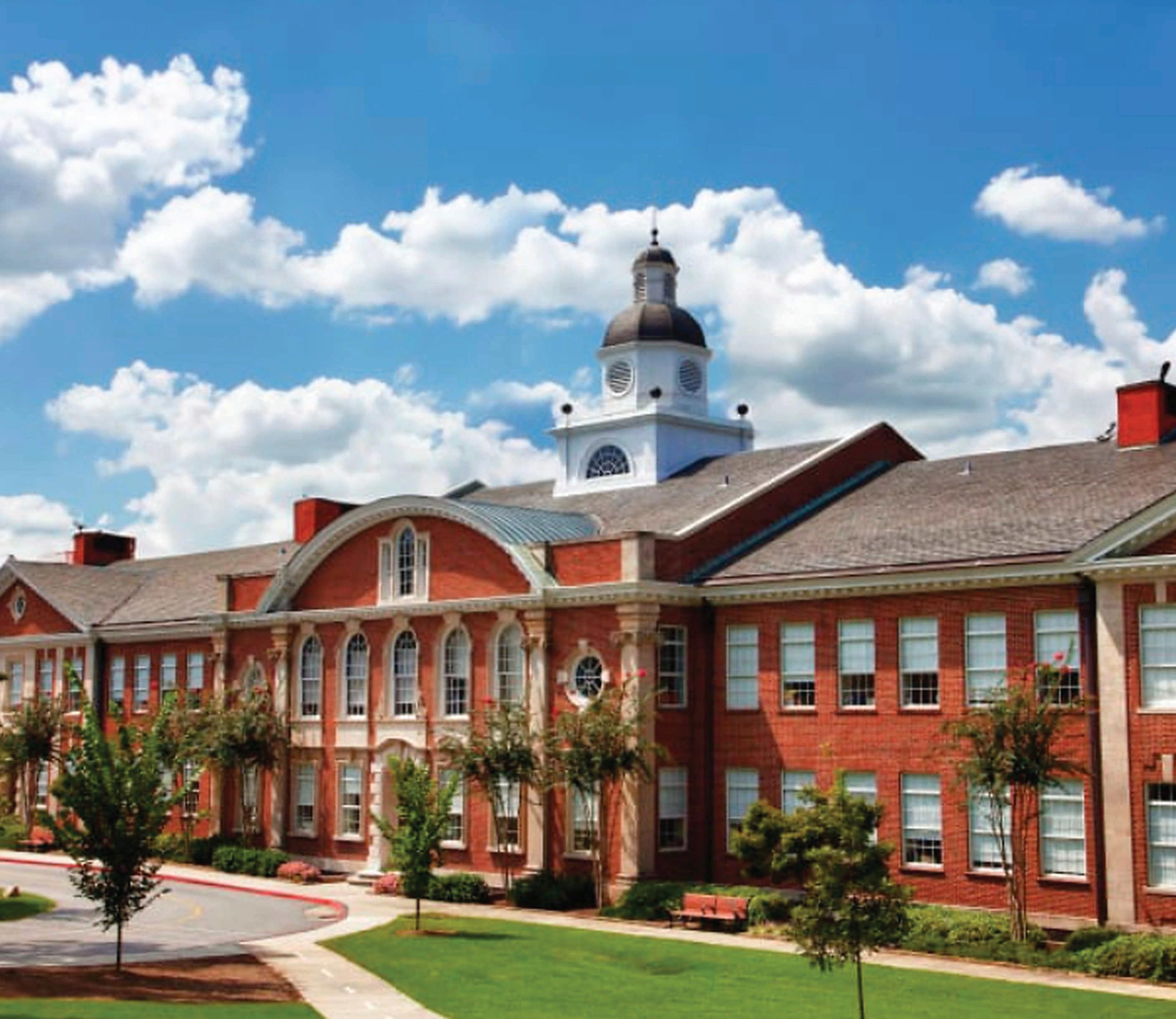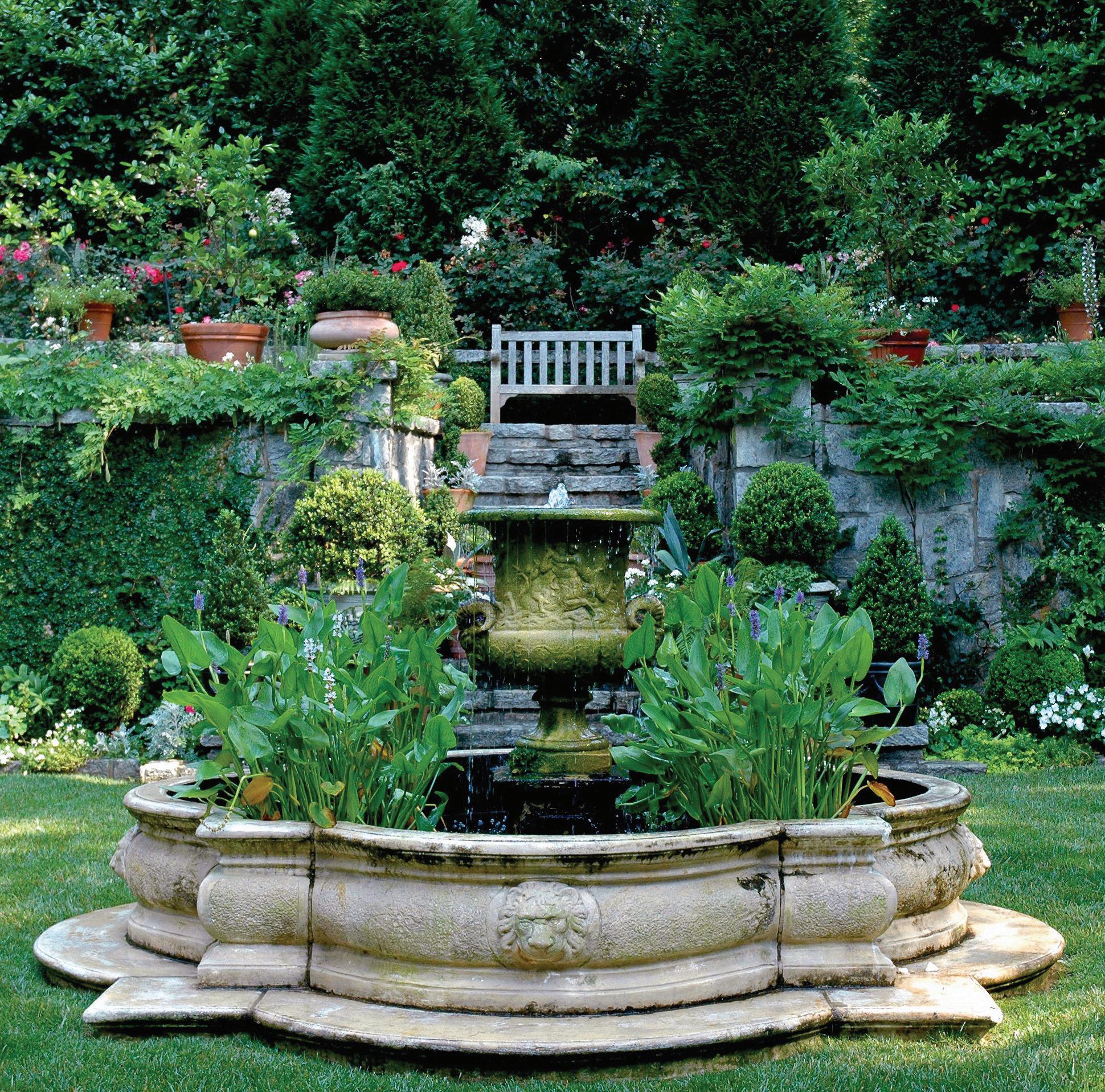
SINCE 1925
SINCE 1925
“Announcing the most notable residential development in Atlanta’s history—Beautiful Garden Hills.”
—From a 1926 newspaper advertisement promoting the new subdivision

SINCE
1925



SINCE 1925
“Announcing the most notable residential development in Atlanta’s history—Beautiful Garden Hills.”
—From a 1926 newspaper advertisement promoting the new subdivision

1925

SINCE 1925
Copyright 2025 © Garden Hills Civic Association, Inc.
All rights reserved. No part of this book may be reproduced or transmitted in any form or by any means, electronic or mechanical, including photocopying or recording, or by any information storage and retrieval system, without permission in writing from the Garden Hills Civic Association, Inc.
Garden Hills Civic Association, Inc.
P.O. Box 52498
Atlanta GA 30355 GardenHills.org
Authors
Leslie Waters
Monica Price Schmid
Contributing Authors
Christopher Sanders
Janet Tomko
New Photography
Laure Glorieux
BOOK DEVELOPMENT
Editor
Rob Levin
Cover and Book Design
Amy Thomann
Project Management
Stacy Moser
Production Management
Renée Peyton
Covington, Georgia www.bookhouse.net
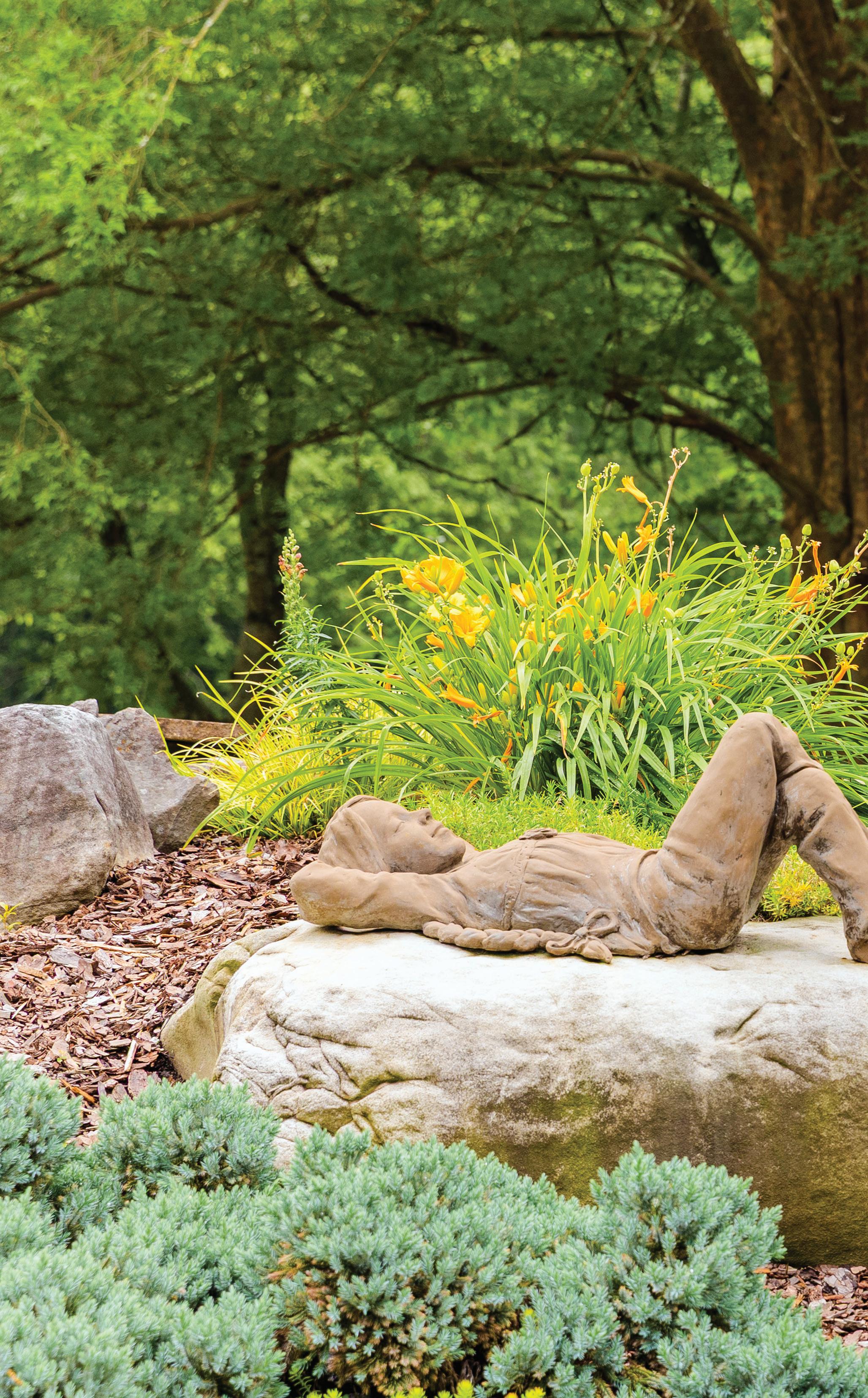
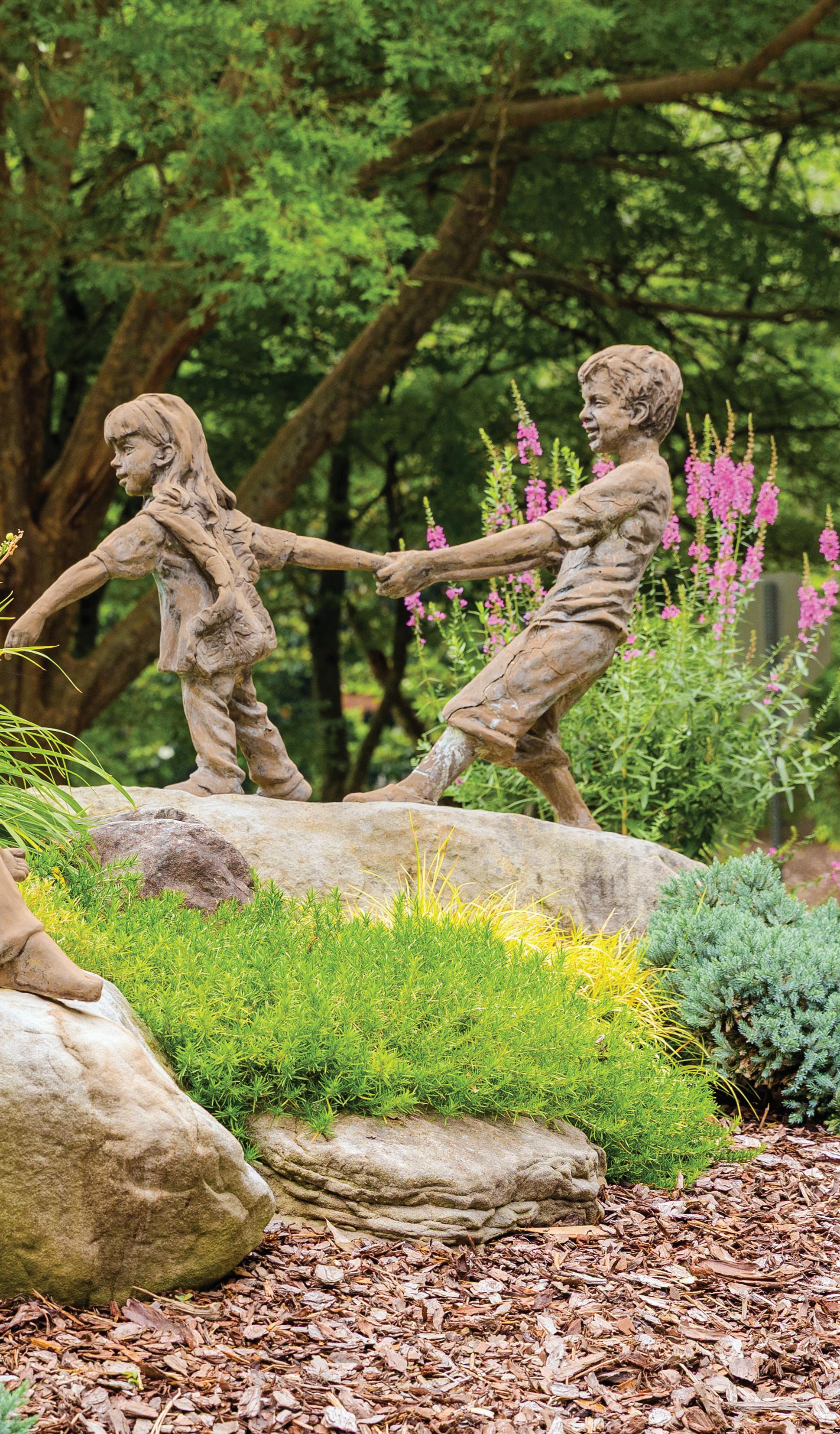
This book was made possible by the Garden Hills Civic Association.
GHCA Officers and Directors 2025–2026
President — Bart Bruckert
Vice President — Jeff Mitchell
Secretary — Elizabeth Porter
Treasurer — Harrison Bell
Directors
Aujla, Prital Bell, Harrison Bennett, Susan Bruckert, Bart Collier, Ken Floyd, Jim Garcia-Sjogrim, Humberto Glass, Kevin Gunther, Lisa Harrison, Kathleen Lambert, Craig Levine, Jim Lowe, Janey Mendosa-Singh, Amber Meriwether, Charles Mitchell, Jeff Porter, Elizabeth Porter, Melissa Ramsey, Ryan Ryder, Robin Sanders, Chris Schmid, Mark Schneider, Bob Thomsen, Jim Waldrop, Harold
CHAPTER ONE Before Us—From the Muskogee to Early Subdivisions
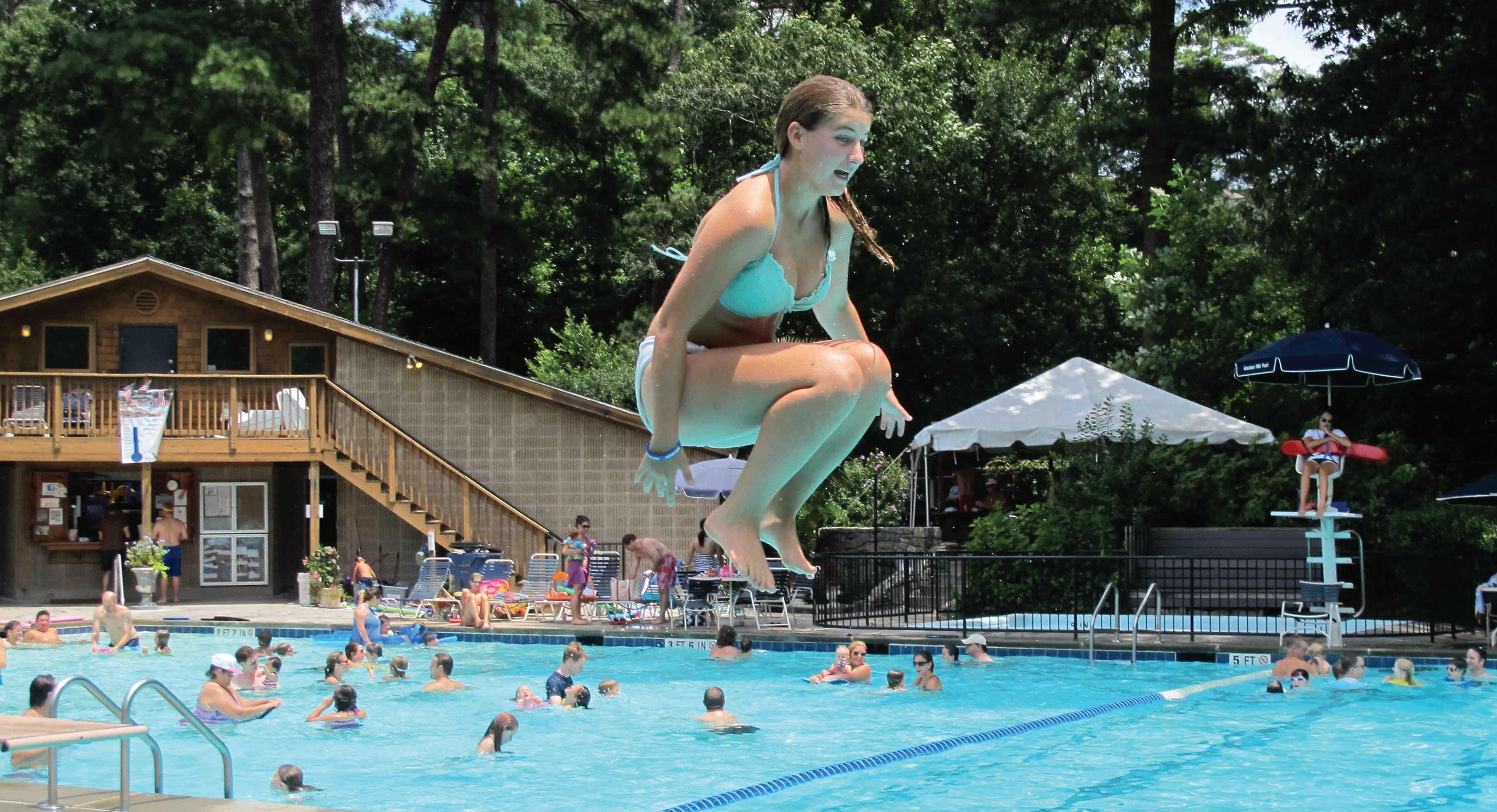
CHAPTER TWO Phillips Campbell McDuffie—Laying the Foundation for Garden Hills
CHAPTER THREE The “Homes Beautiful”— Showcasing the Garden Hills Vision


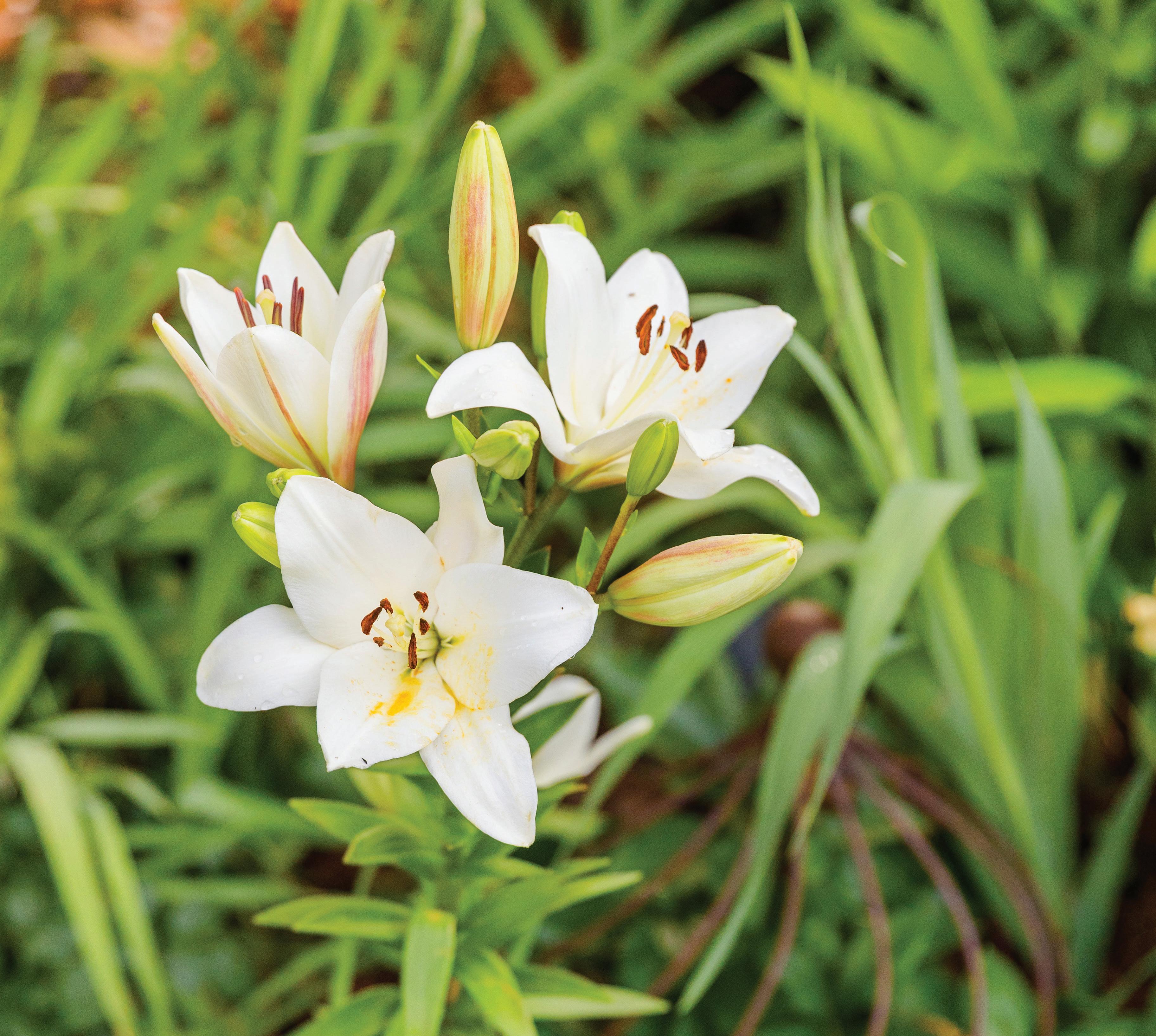

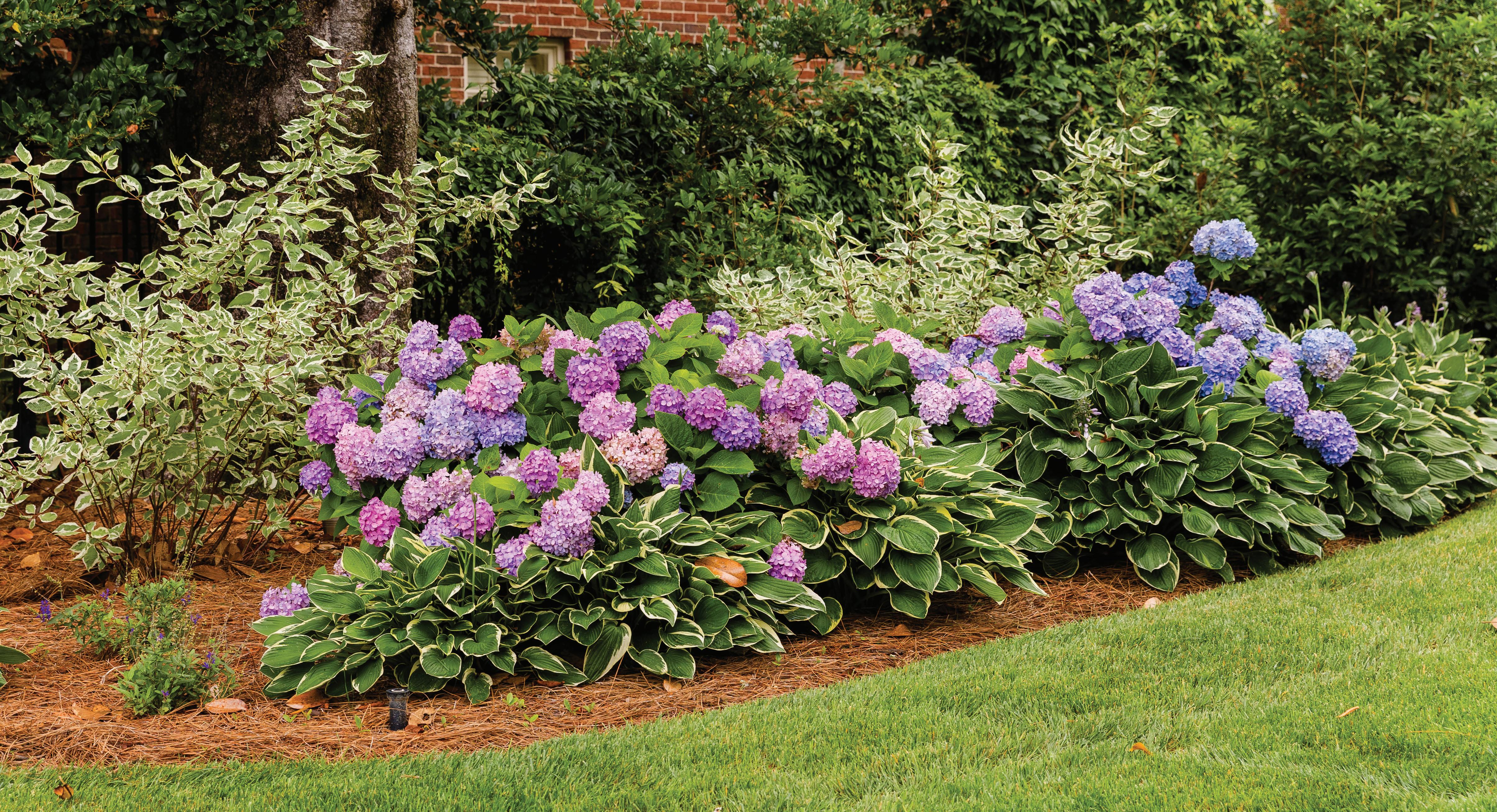
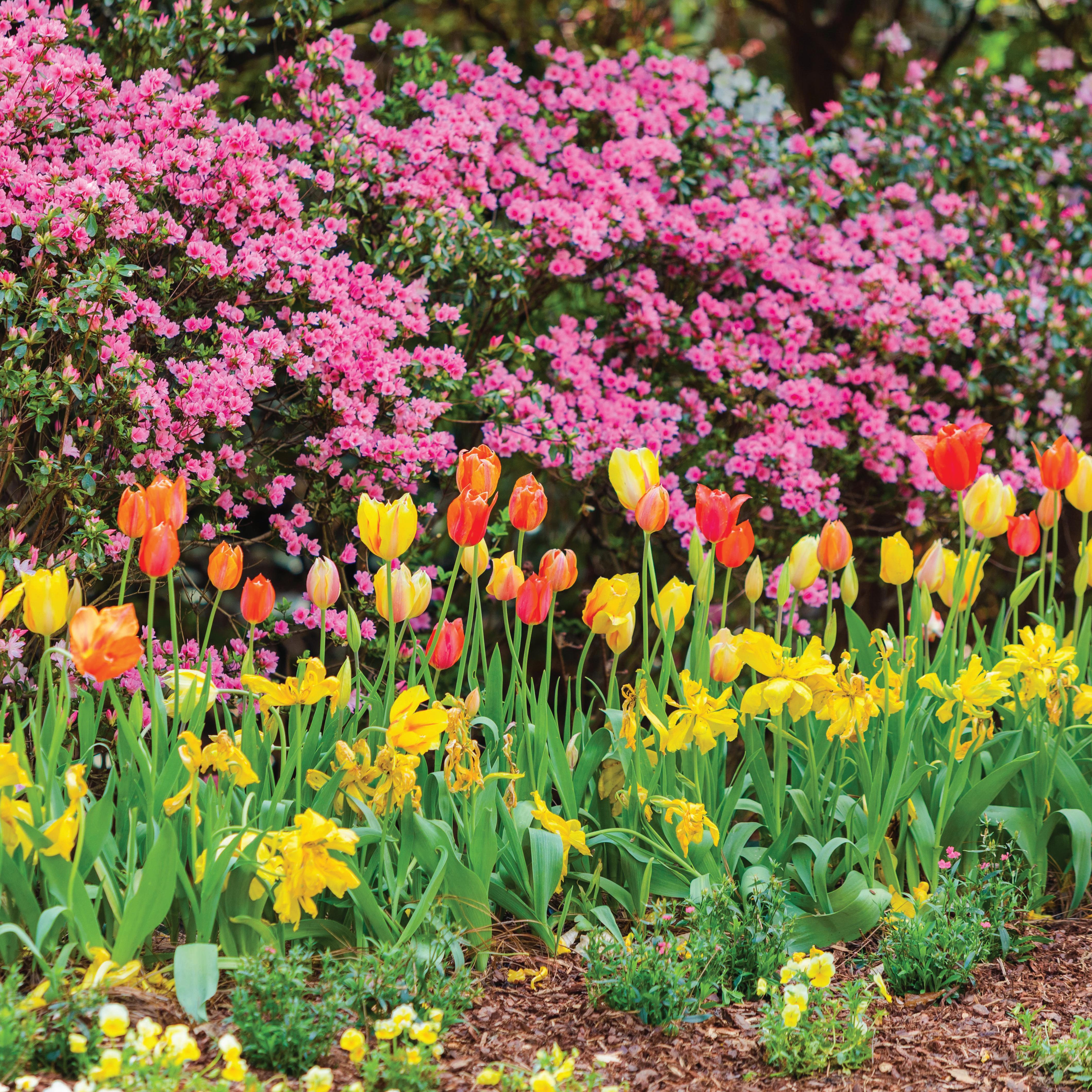
Strolling down curvilinear streets, soaking in front-yard landscapes dotted with hydrangeas, azaleas, and dogwoods, passing rolling creeks and wooded parks, smelling the early honeysuckles and gardenias—nature is abundant. The distinctive hoot of an owl, the hawk in an oak tree eyeing his prey, the chirp of robins, brown thrashers, and red birds are all commonplace. One might even spot a passing deer, fox, or coyote.

Just as deer sneak refreshment at Sunny Brook creek or the red fox finds wooded refuge in Alexander Park, so it seems the inhabitants of Garden Hills find restoration in this slice of nature nestled in the heart of Atlanta’s famed Buckhead district.
The original descriptors that lured our first neighbors to this place have stood the test of time:
“The most perfect blending of location and natural beauty ever offered investors or home seekers in Atlanta.”
“Not on the edge of what’s going to be, but right in the center of things that are.”
“A natural rustic beauty spot comparable to the hills of North Georgia.”
“The most unique landscaping plan ever attempted in an Atlanta Development.”
“Each homesite or estate will be individual, distinct—a little Kingdom of its own—with all of the beauty of the countryside, and yet in the heart of Atlanta’s finest Residential section.”
“Rustic bridges over rippling brooks.”
“Naturally beautiful, with rolling pine-covered hills and rocky brooks . . . made even more exquisite by a carefully designed beautification scheme of Americas foremost landscape architects.”
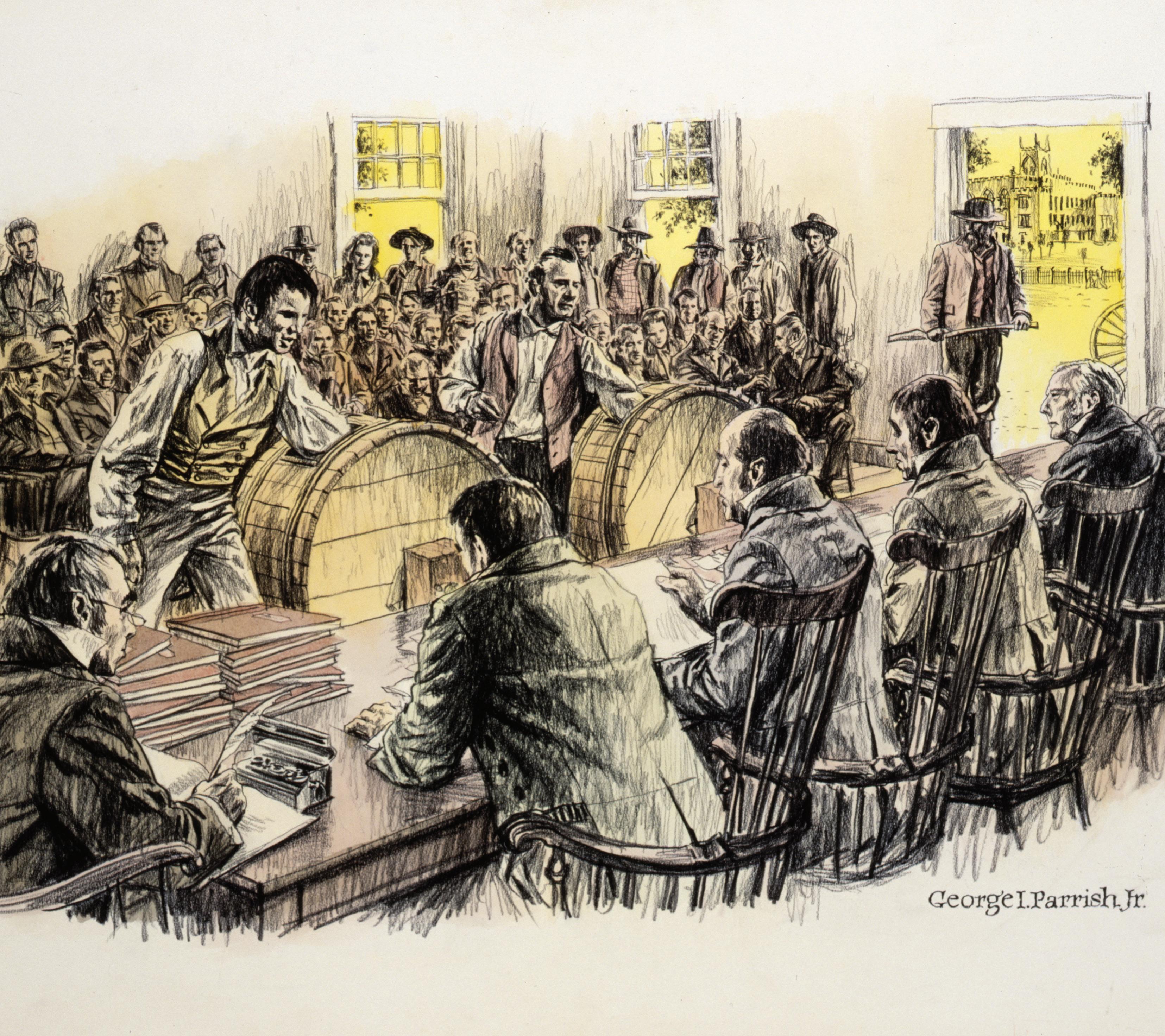
The land that would become Garden Hills was relinquished by the Muskogee Indians to early English settlers at the signing of the Treaty of Indian Springs in 1821. From 1805 to 1833, Georgia conducted land lotteries to deed acreage to “fortunate” winners. Eligible names were placed in a rotating drum. A second drum contained tickets with land lot numbers. The drums were spun simultaneously and tickets pulled and matched. The winners became land owners upon paying a grant fee. Drawing by George I. Parrish Jr., courtesy of the Atlanta History Center.
RIOR TO THE FOUNDING OF
the Georgia Colony by James Oglethorpe in 1733, our Garden Hills was inhabited by the Muskogee Indians. The tribe was referred to as the “Creeks” because they lived, hunted, and fished along the banks of the Chattahoochee and its tributaries.
“ All was new—waters in the creeks and rivers as clear as crystal; rich valleys, hills, and mountains covered with a thick forest; a land of beautiful flowers—white, pink, yellow, and red honeysuckles, redwood and dogwood blossoms, wild roses and other beauties. There was plenty of wild game—deer, turkey, and other varieties. When first seen, all was in lovely, beautiful spring, and I was nine years old.”
—Reverend William Jasper Cotter, circa 1832
Following the American Revolutionary War, the War of 1812 broke out between the United States and the United Kingdom over land boundaries. During that time, the Creek Indian War of 1813–1814 bubbled up, with Chief Tecumseh’s “Red Sticks” (referring to the color of their war batons) fortifying the British while the Lower Muskogee aligned with the United States. In 1814, the Red Sticks were defeated.
From 1739 until 1832, the Muskogee slowly relinquished their land to the English settlers. The Treaty of Indian Springs, signed on January 8, 1821, ceded the area between the Flint and Ocmulgee Rivers for a sum totaling $200,000. This included the land that would become Atlanta and our Garden Hills.
The son of a War of 1812 veteran, young Reverend William Jasper Cotter, kept an account of this land—his father had traded at the Muskogee village “Standing Peachtree” near the confluence of the Chattahoochee and Peachtree Creek.
After the American Revolutionary War, Georgia claimed territory as far west as the Mississippi River. From 1805 to 1833, Georgia conducted land lotteries to deed acreage to private citizens, with a special intent to reward those who had fought in the war.
Of the eight Georgia land lotteries, the tracts of land that would become our present-day Garden Hills were eligible in the fourth drawing, the 1821 land lottery. Deeded tracts were 202½ acres in size and the grant fee was nineteen dollars. The tracts were part of District 17 of the newly formed Henry County. They later became part of Fulton County, once it was established in 1853. The “fortunate” winners of the 1821

Shown are the portions of the three land lots (100, 60, and 59) granted in the 1821 Georgia land lottery that would become Garden Hills.


This 1872 map highlights the three 1821 Georgia land lottery lots (noted by red stars) that later comprised Garden Hills. Henry Irby’s store (noted by a blue star) was located at the confluence of presentday Peachtree, Roswell and East Paces Ferry Roads (old Indian trails) in Irbyville (present-day Buckhead). Land owned by Irby’s daughter, Sarah Hicks, was later sold to P.C. McDuffie to create Garden Hills.
Georgia land lottery for the land that would become Garden Hills included Lot 100, granted to Mr. Isaac Blount; Lot 60, granted to Mr. Jeremiah Harris; and Lot 59, granted to Mr. Edmund Randle. Over time, the tracts changed ownership.
Interestingly, Mrs. Sarah Hicks, whose land would be sold to Garden Hills founder Phillips Campbell McDuffie to create Garden Hills, was the daughter of Mr. Henry Irby, who effectively founded the famed Buckhead area in Atlanta.

“ People from North Georgia would come to Atlanta for business in their oxen drawn wagons and bring their families. They would camp next door to Henry Irby’s store. They would come down and spend the night and then the next morning their husbands would go in their horse-drawn wagons down to Tenth Street, which was, at that time, the northern most part of Atlanta and they had horse-drawn trollies that would go into Atlanta from there. So, the men would go on to Atlanta and attend to business and then go back to camp grounds where their families had been visiting each other all day. And they would spend another night before heading back home the next morning. This was after the Civil War but before the turn of the century.”
Henry Irby (1807–1879) arrived in Atlanta in 1837, the year the city was founded. Although not a land lottery participant, he was fortuitous in that he purchased the 202½-acre Land Lot 99 from “fortunate” Georgia land lottery winner Daniel Johnson on December 18, 1838, for $650. Today, this land comprises Buckhead Village.
Irby wisely opened a store and tavern along the old Peachtree Indian trail that eventually made its way south from the present-day intersection of West Paces Ferry, Peachtree, and Roswell Roads to Atlanta. It was a welcomed stop offering food, drinks, and shopping, similar to what those visiting
—Mrs. Binion Jordan, great-great-granddaughter of Henry Irby (courtesy of an interview with Buckhead historian Susan Kessler Barnard documented at the Atlanta History Center)
Buckhead seek today. Initially, the area was designated as Irbyville, referring to Irby’s 803-acre land holdings in the vicinity. By 1888, though, the community became known as Buckhead, thanks to the ill-fated deer’s head hung near Henry Irby’s popular tavern. It was also referred to as Atlanta Heights, after the city of Atlanta was established.
■ Bachelor, 18 years or older, 3-year residence in Georgia, 3-year citizen United States (1 draw)
■ Married man with wife or son under 18 years or unmarried daughter, 3-year residence in Georgia, 3-year citizen United States (2 draws)
■ Widow, 3-year residence in Georgia (1 draw)
■ Family of minor orphans, father dead, 3-year residence in Georgia (1 draw)
■ Family (one or two) of orphans, father and mother dead (1 draw)
■ Family (three or more) of orphans, father and mother dead (2 draws)
■ Widow, husband killed or died in War of 1812, or Indian War, 3-year residence in Georgia (2 draws)
■ Minor orphan, father killed or died in War of 1812, or Indian War (2 draws)
■ Child or family of children of a convict, 3-year residence in Georgia—entitled in the same manner as orphans
Persons Excluded
■ Any fortunate drawer in any previous land lottery.
■ Citizens of the state who volunteered or were legally drafted during the War of 1812 or Indian War and refused to serve a tour of duty in person or by substitute.
■ Any convict in the penitentiary.
■ Any tax defaulter or absconder for debt.
Source: Random Acts of Genealogical Kindness website–RAOGK.org

Pictured are Henry Irby’s daughter, Sarah (Irby) Hicks, and her husband, Rial Bailey Hicks, whose land McDuffie would purchase to create Garden Hills. Rial was postmaster of the “Buck’s Head Post Office” in Irby’s store from 1853 until its closing in 1861. In 1878, Rial bought Land Lot 99 (present-day Buckhead Village) from Henry Irby for $4,000. Courtesy of the Atlanta History Center.
On Christmas Eve 1886, Sarah (Irby) Hicks purchased 127 acres of the southeast portion of Land Lot 100 for $1,800 from the Crawford family. She subdivided the land into seven lots, keeping one for herself and her husband, Rial, and gifting the remaining six to her living children. The area became known as the “Sarah Hicks Subdivision.” Two of Sarah and Rial’s daughters, Otella Mae (Hicks) Donaldson and Mary Ophelia (Hicks) Ivey, would marry, establish homes, and raise families on the inherited land. With time, after acquiring land from siblings, the Donaldsons owned Lots 2, 3, and 7 and the Iveys owned Lots 4, 5, and 6 of the Sarah Hicks Subdivision.
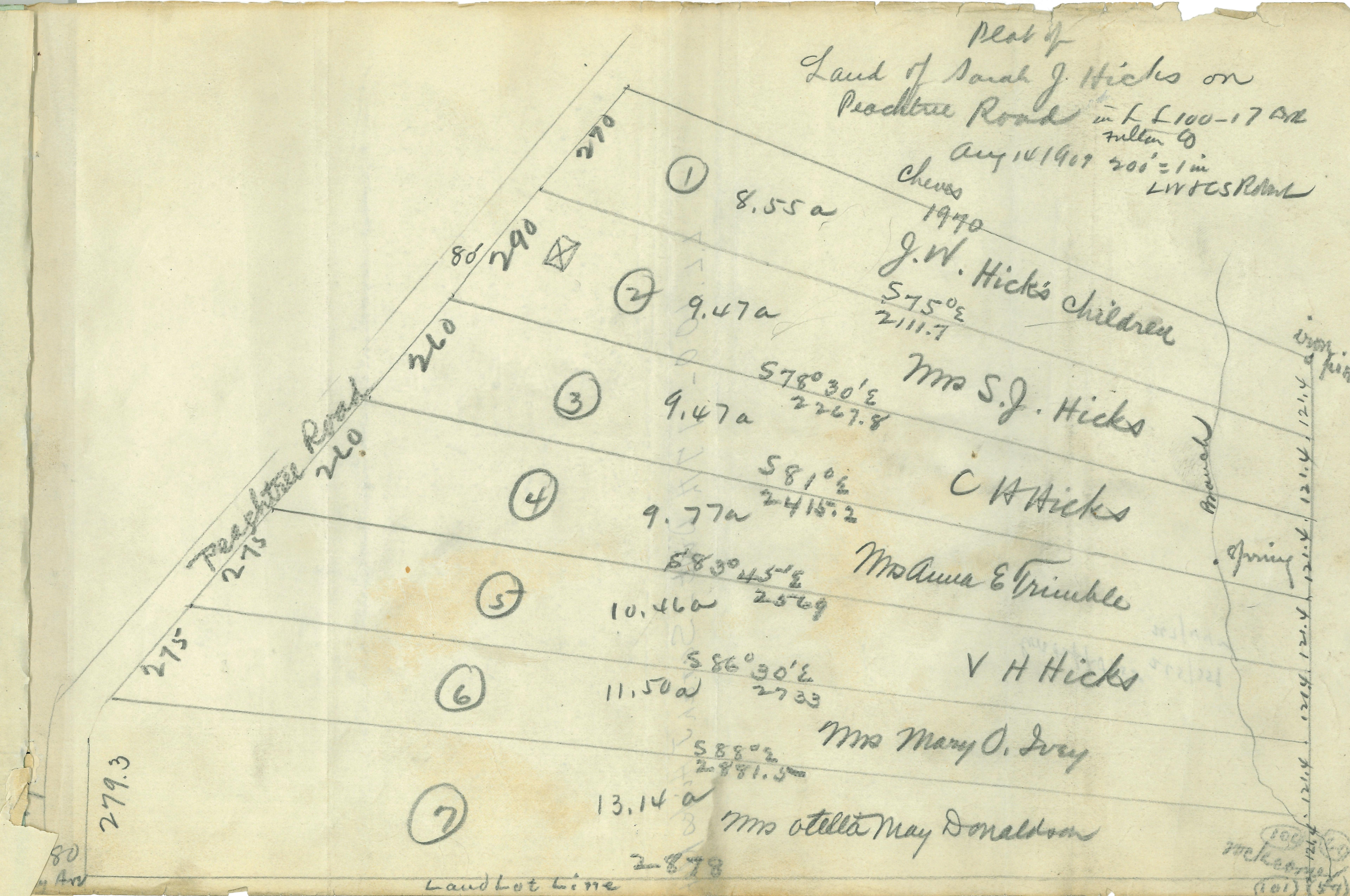

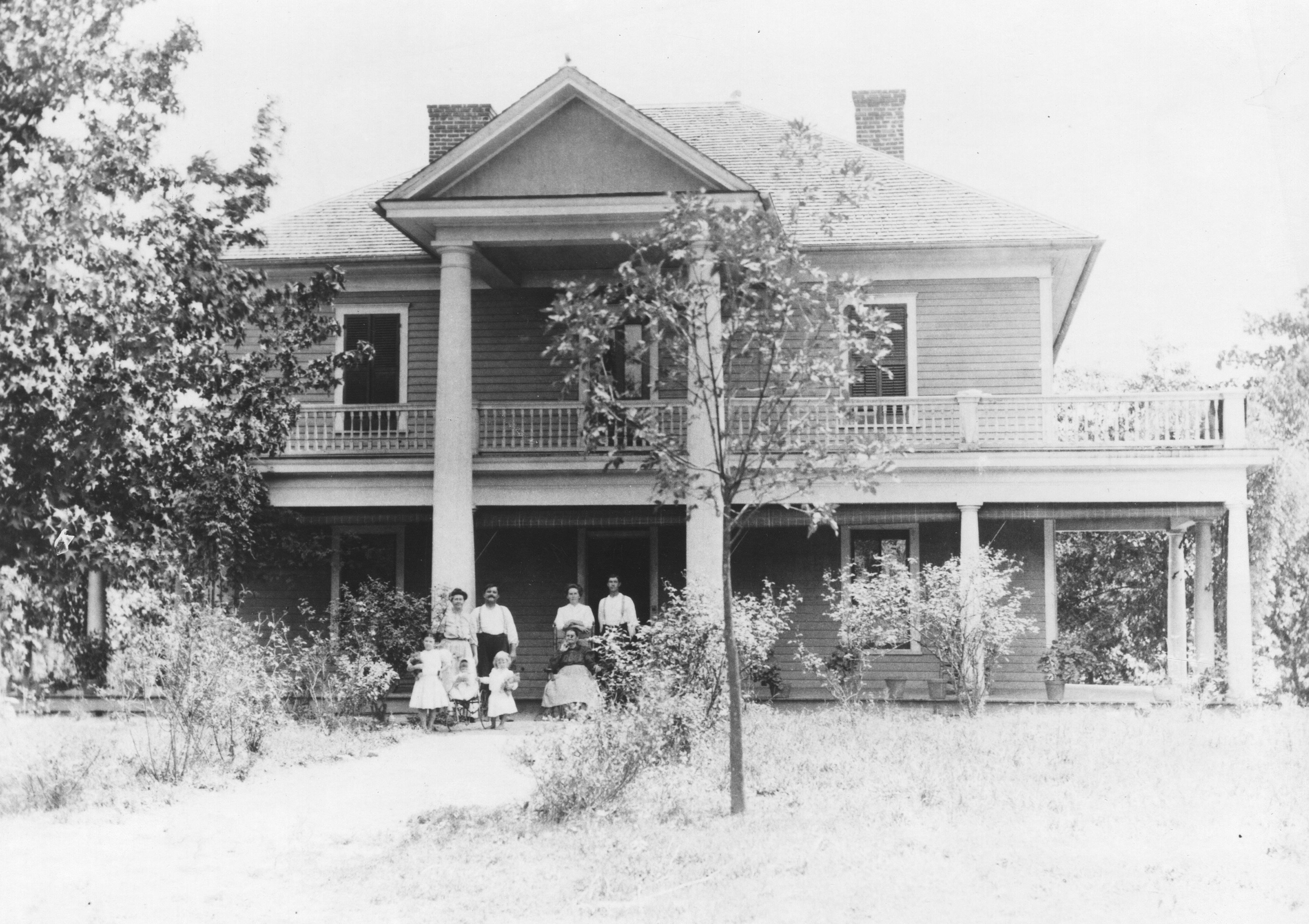
(Top left) A sketch of the “Sarah Hicks Subdivision” from an original land deed shows the seven subdivided lots of 127 acres of Land Lot 100, which fronted Peachtree Road. Sarah gifted land to each of her six children out of “love and affection”—and a few dollars to make it legal. In 1924, McDuffie purchased a portion of the land from the Hicks family to create “Beautiful Garden Hills.”
(Top right) This sketch from an original land deed (circa 1926) shows P. C. McDuffie’s overlay of Rumson and Bolling Roads, Rumson Way, and East Wesley Avenue on Lots 4 through 7 of the “Sarah Hicks Subdivision.”
(Left) The home of Rial and Sarah Hicks on Lot 2 of the “Sarah Hicks Subdivision” (then 2725 Peachtree Road) was a two-story wooden home with “beautiful parquet floors and crystal chandeliers.” Today, a six-story office building called 2827 Peachtree sits in its place. The home, reportedly demolished in 1982, sat directly behind the Garden Hills Cinema and was then accessed via Rumson Road. Sarah, pictured here in a wheelchair, was in ill health during the final four years of her life after suffering a fall.
All photos this page courtesy of the Atlanta History Center.
Otella Mae (Hicks) Donaldson, known as “Mae,” and her husband, Sylvanus, known as “Syl,” shared their home at 2725 Peachtree Road with Sarah Jane (Irby) Hicks, when she became widowed. Syl was a reputable contractor who helped build some of Atlanta’s prominent subdivisions, including Ansley Park, Peachtree Heights, and Andrews Drive. Sarah resided in the home until her death in 1924 at the age of eighty-seven. Syl died the following year at the age of fiftyfour. The Donaldsons sold land to P. C. McDuffie to create

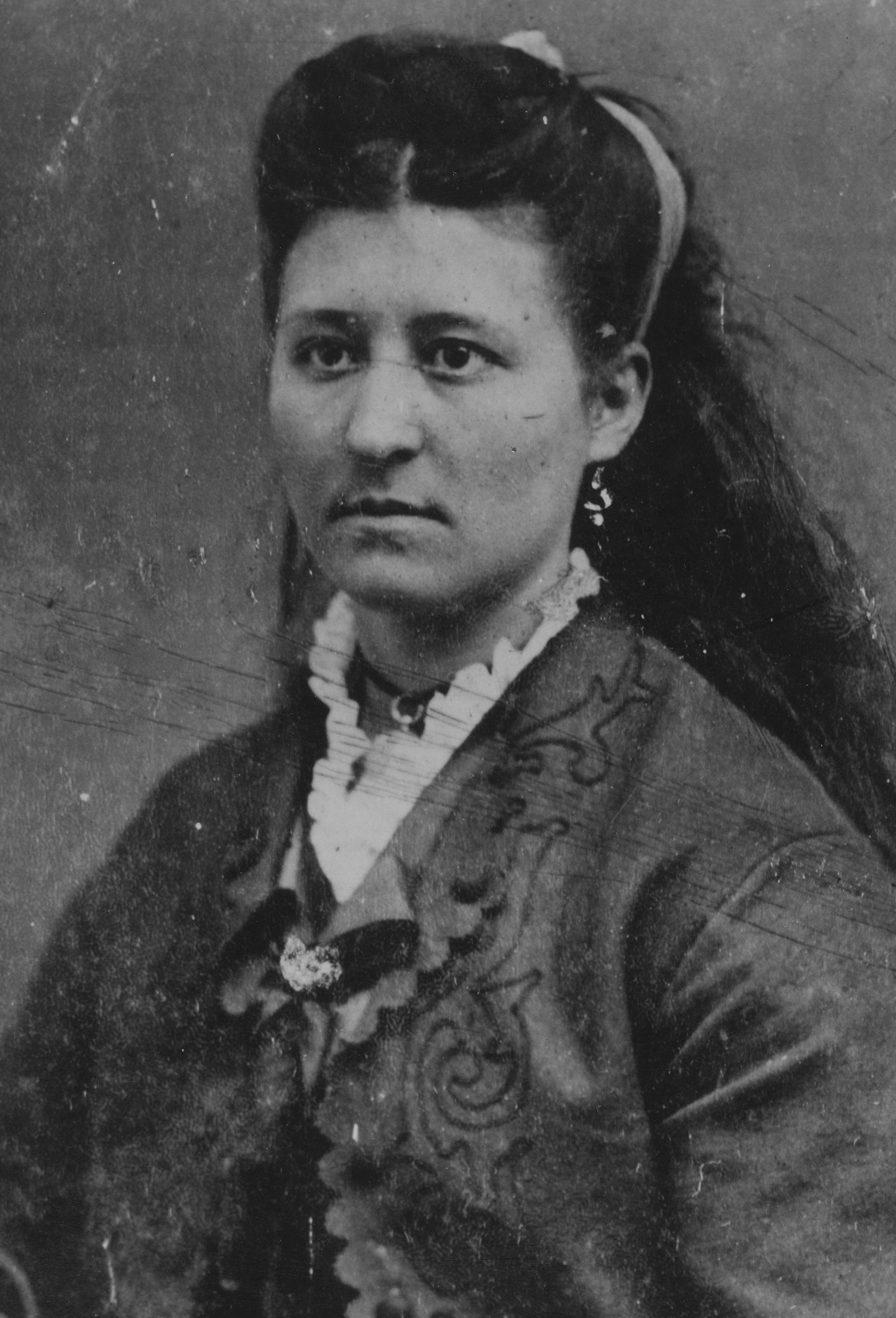
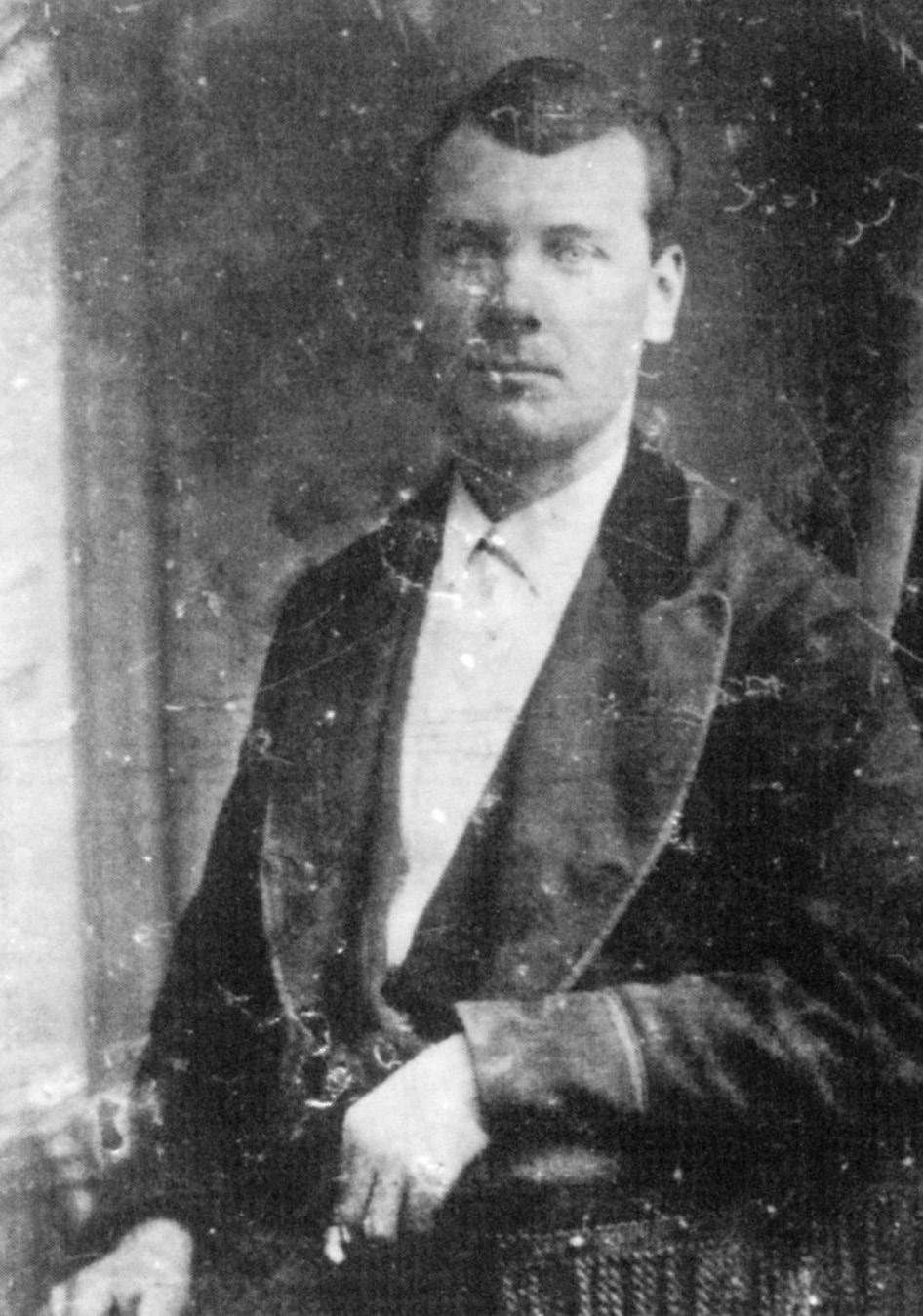
Garden Hills. Widow Mae moved into a home at 185 Bolling Road in the new Garden Hills Subdivision circa 1928.
Seaborn Ivey farmed the land and built a saw mill beside the house he shared with his wife, Mary Ophelia, at 2711 Peachtree Road. He sold wood to the well-to do in the area.
The Iveys hosted an annual barbecue, serving Brunswick stew with a hog roasted in their backyard pit with the help of local “old Peter Curry.”
In 1920, the Iveys sold their home and Peachtree Road frontage of Lots 4, 5, and 6 of the Sarah Hicks Subdivision for $30,670 to Mr. Beverly DuBose where he and his wife, Lula, would later raise their family. Beverly DuBose became a widely known Atlanta historian, accumulating an outstanding collection of documents about Southern history. He was director of the Atlanta Historical Society and a trustee of Egleston Hospital. Eventually, Beverly sold some of his land to P. C. McDuffie to build Garden Hills.

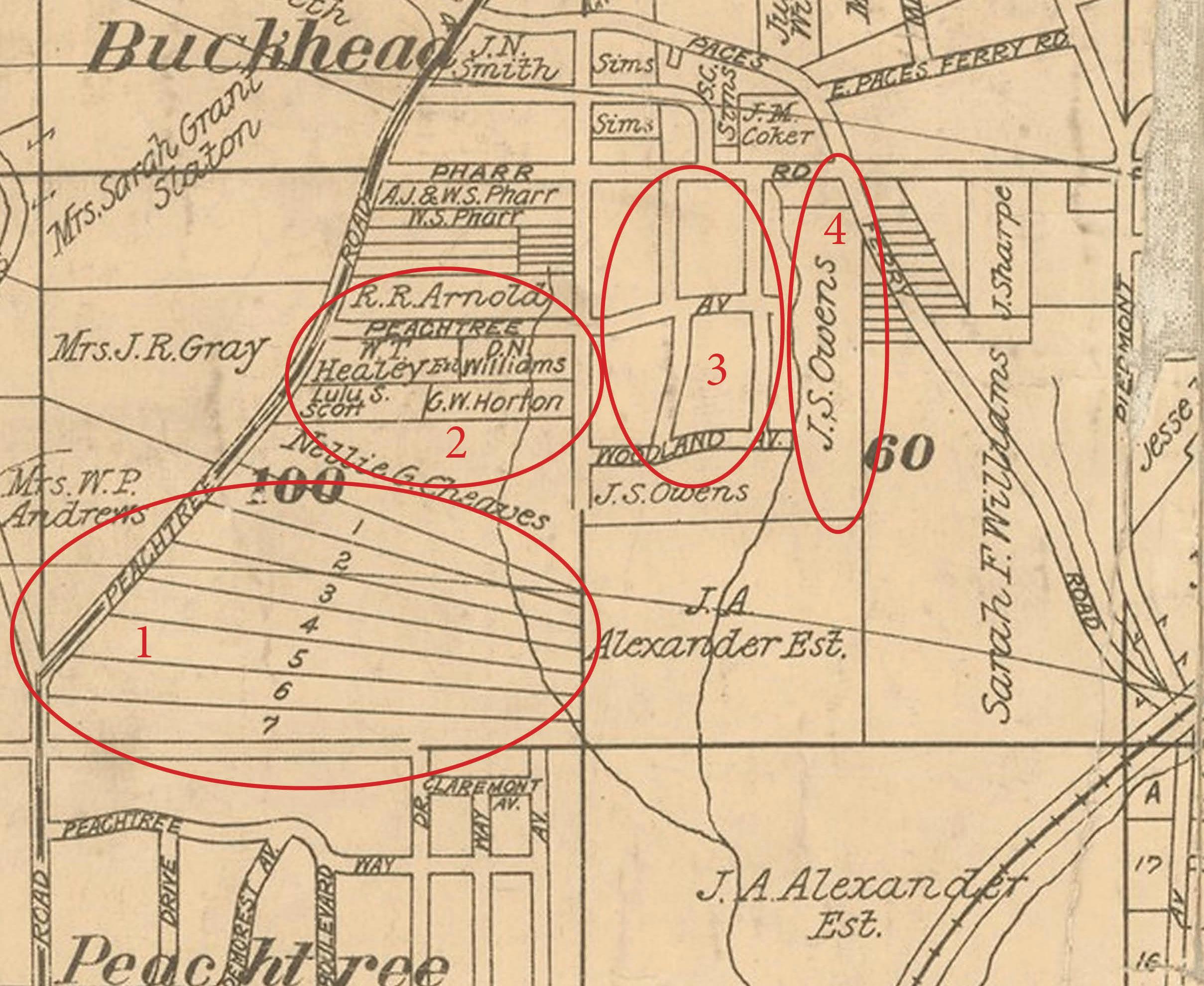
(Left) The Ivey home was built on Lot 6 of the Sarah Hicks Subdivision at present-day 2711 Peachtree Road. Today, the homesite is the parking lot of the Second-Ponce de Leon Baptist Church in Garden Hills (right). Courtesy of the Atlanta History Center.
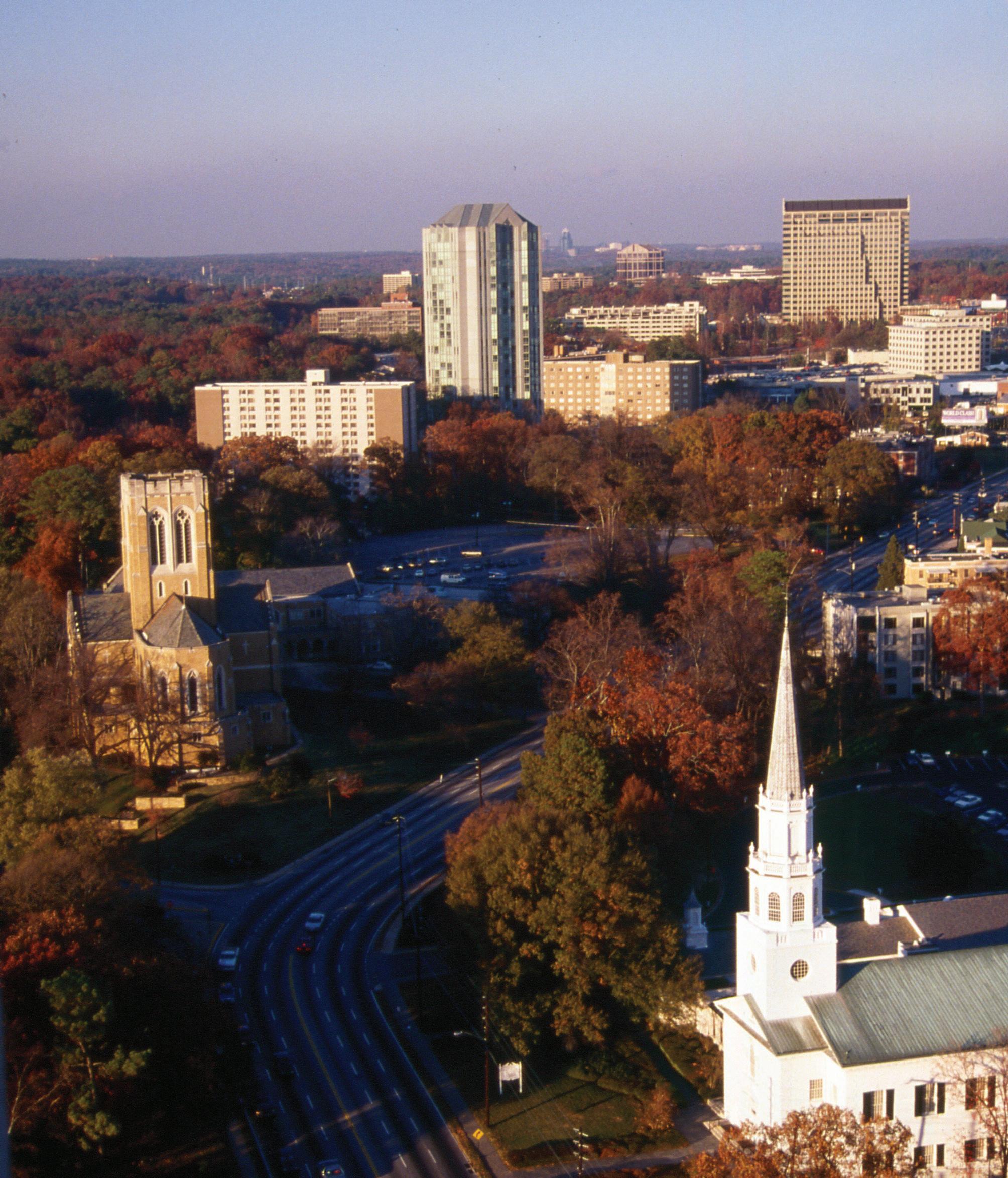
(Left) This 1921 map shows four emerging subdivisions on Land Lots 60 and 100 deeded in the 1821 Georgia land lottery that would later become a part of Garden Hills: (1) Circa 1886, seven parcels of the Sarah Hicks Subdivision fronting Peachtree Road that, in 1925, became the original section of historic Garden Hills. (2) Circa 1923, these parcels became the Beverly Hills Subdivision that is present-day Garden Hills Delmont/Sheridan area where the Atlanta International School and Garden Hills Elementary are located. (3) Circa 1910, this property became the Peachtree View Subdivision, affectionally known today as Garden Hills North 40. (Note: Woodland Avenue shown here is present-day Delmont Avenue.) (4) Circa 1921, this property became the Macedonia Park Subdivision that is today’s Bagley Park. Courtesy of the Atlanta History Center.
Beyond the Sarah Hicks Subdivision, circa 1886, that fronted Peachtree Road, three additional neighborhoods were poised to fold into Garden Hills: the Peachtree View Subdivision, founded circa 1910; the Macedonia Park Subdivision, circa 1921; and the Beverly Hills Subdivision, circa 1923.
In 1910, a burgeoning Holmes & Verner Realty Company purchased some forty acres of land in the northwest corner of Land Lot 60 from John Sheffield Owens for $45,000. This land would later become the Garden Hills “North 40.” Owens was described as a “wide-awake real estate dealer,” co-developing important subdivisions like Peachtree Heights East (1908) with his brother, Frank Owens. He was a successful banker, becoming vice president of Central Bank & Trust Company. Early on, he operated a drug store and was known to friends as “Doc” Owens.
The subdivision was named “Peachtree View” because it rose 200 feet higher than the elevation of Atlanta, providing fine views of the city’s skyline. Advertisements touted that one
could see “the dome of the capitol, the imposing spire of the First Baptist church, the Candler building, the Fourth National Bank building, the Third National Bank building and many other structures” from the homesites. Today, visitors can still pause at Peachtree Avenue atop Grandview Avenue to take in a “grand view” of Atlanta’s downtown lights before descending into the neighborhood.
The subdivision was just a “stone’s throw from the best car service and the finest highway in the country (Peachtree Road), 6 miles from Atlanta center.” Built on thickly covered land with beautiful natural shade from pines, oaks, and hickories, the drives, roadways, and serpentine walks were artistically designed by W. J. Nalley, a well-known civil engineer and landscape gardener. With the homesites located so close to the Buckhead car line it was claimed:
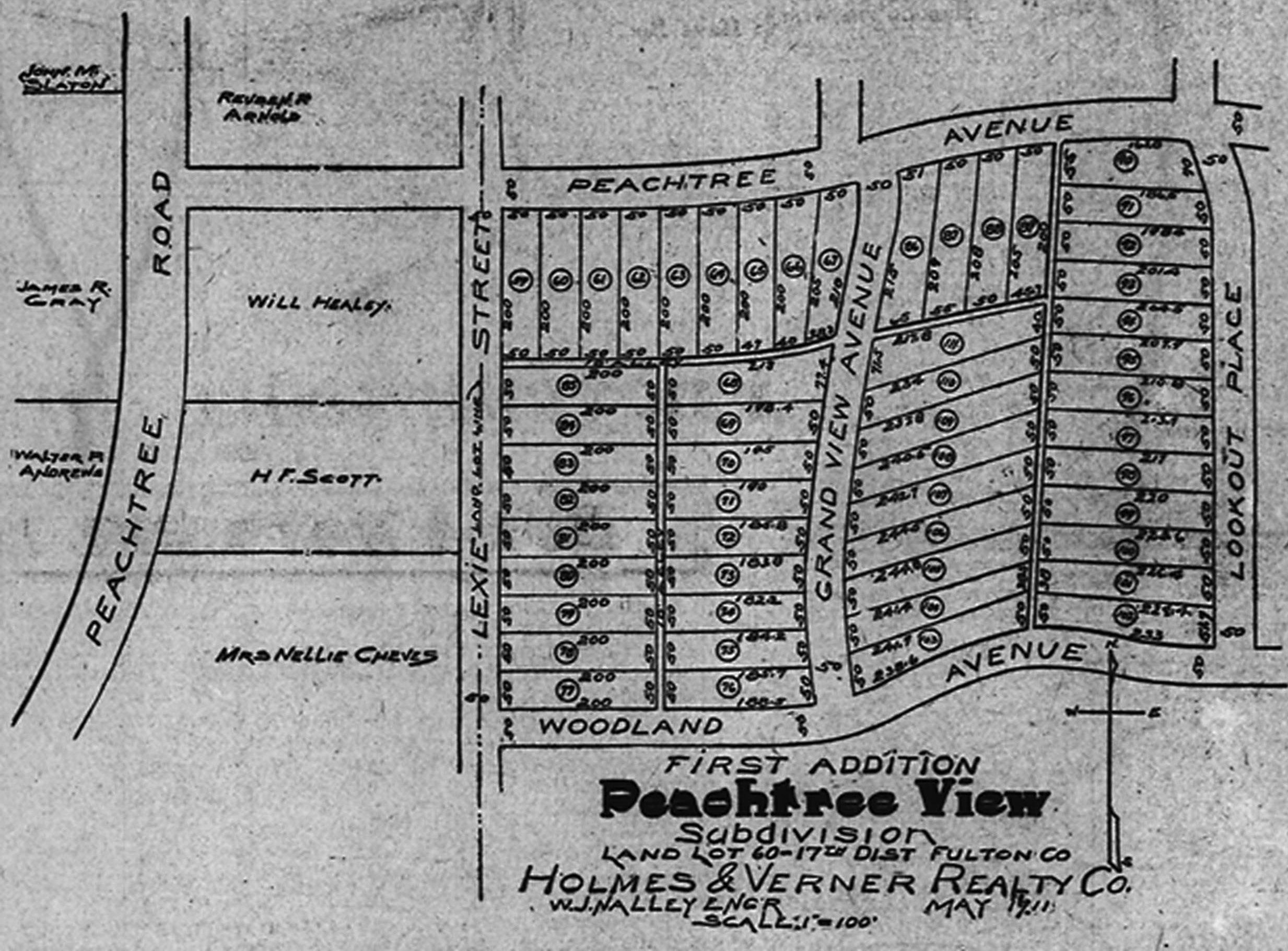
This 1911 plat was used by Holmes & Verner Realty Co. to auction the 111 homesites of the Peachtree View Subdivision. The price of the lots was between $300 and $1,000. Note: Lookout Place dead-ended into Woodland Avenue (present-day Delmont) until about 1949. Present-day North Fulton Drive was named Lexie Street until about 1945. The subdivision would later become the Garden Hills North 40.
“There is no reason why the salaried man may not own a country home as well as the man of means whose automobile takes him to and from the city.”
Before selling off the forty acres that would become the Peachtree View Subdivision, John Owens purchased sixty acres of land in the northeast corner of Land Lot 60 from Joshua Crawford in 1906. He paid $5,000. This land would later become present-day Bagley Park.
Prior to Owens’ purchase, African Americans, free since the end of the American Civil War (1861–1865) were tenant farmers on Crawford’s land. As their work wages were low, they supplemented their income by growing crops. They established the Mount Olive African Methodist Episcopal Church and cemetery at the front of the community on “Line Road” (present-day Pharr Road).

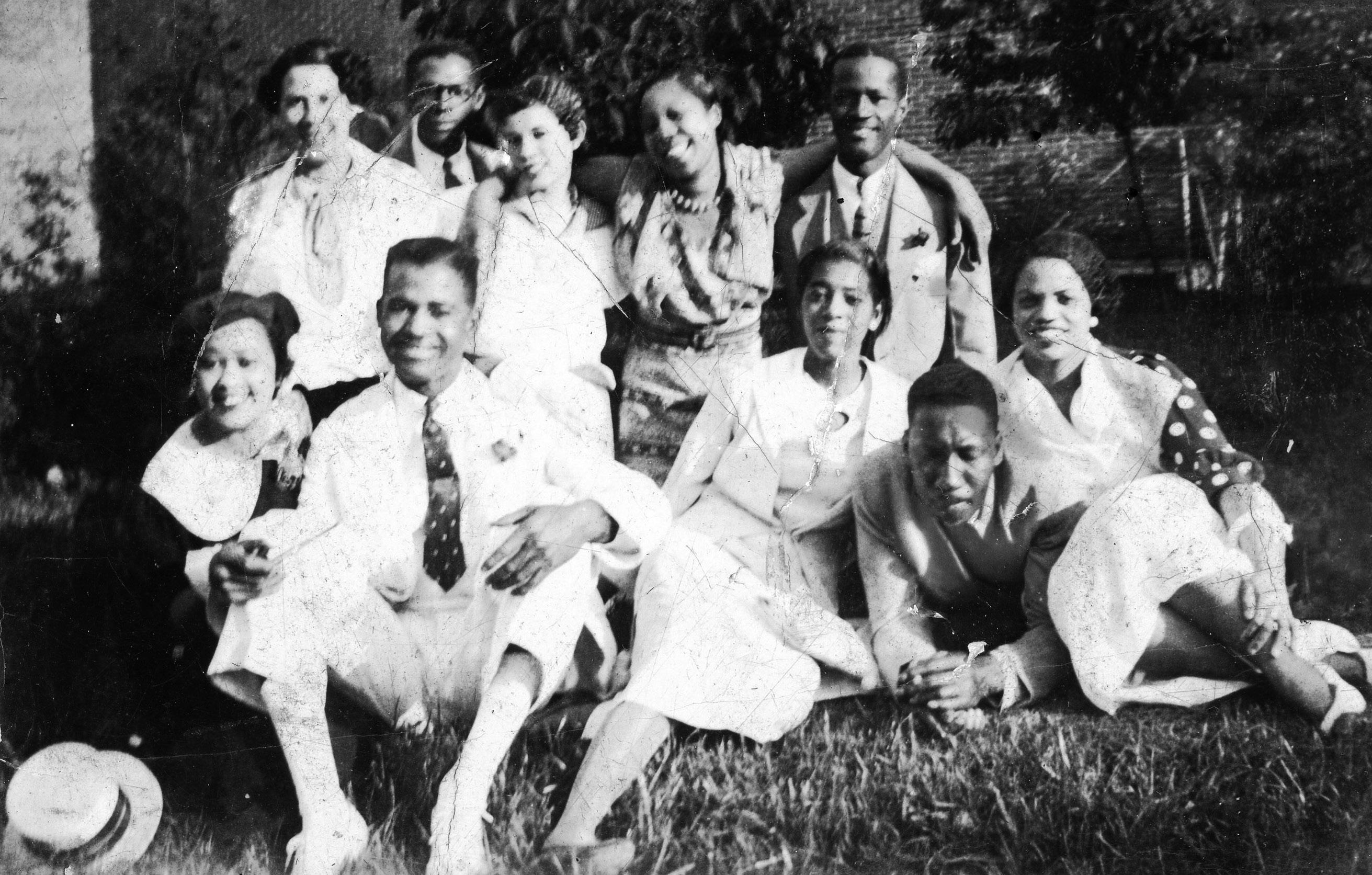
Pictured front row left are William Bagley’s daughter, Wille Mae (Bagley) Butts with husband, Pete Butts, and neighbors in Macedonia Park (present-day Garden Hills Bagley Park). Later, they enjoyed Tuesday night dinners and dancing at the Royal Peacock in downtown Atlanta. The African American community, established there since 1870, grew to around fifty families, some of whom were renters. Courtesy of Elon Butts Osby, granddaughter of William Bagley.
(Left) A 1921 plat map by civil engineer O. F. Kaufman shows the fiftyeight homesites of Macedonia Park. Its main thoroughfare was named Bagley Street after its cherished unofficial mayor, William Bagley. Courtesy of the Atlanta History Center.
In 1921, Owens formalized the community as an African American subdivision because other subdivisions’ bylaws at the time excluded African Americans, including Garden Hills. The subdivision was called Macedonia Park and contained fifty-eight homesites. Willam Bagley, a beloved grocer and prominent member of the community, was dubbed “Mayor” and the area became widely known as Bagley Park. Bagley had moved to the area in 1912, fleeing racial violence in Forsythe County and leaving behind his land. By 1929, he owned six lots in the park and had found a new home.
It was a cohesive, well-established community into the 1940s, with three churches, two grocery stores, and two restaurants as well as a blacksmith shop just across Pharr Road—all owned and operated by community members.
Unfortunately, by the late 1940s, the area became condemned and, between 1945 and 1952, Fulton County bought the entire neighborhood from its landlords with the stipulation that the property would always remain a public park, namely Bagley Park. Picnic areas, outdoor grills, and, later, tennis courts and Buckhead Baseball took root.
In 1980, the park was renamed Frankie Allen Park, after the passing of a favorite baseball umpire. Later, the Mount Olive cemetery (located near the Pharr Road frontage of the park) where William Bagley and his wife, Ida, are buried, was at risk of being relocated by developers. The Buckhead
Heritage Society teamed up with Bagley’s descendants, including their granddaughter, Elon Butts Osby, to petition the city to save it. They succeeded in ensuring the cemetery remained in place and in restoring the Bagley Park name, rightfully preserving the history and commitments that had been made to its early residents.
On June 6, 1923, William Fleming Winecoff formed a family real-estate venture, Beverly Hills Incorporated, with his two sons, William Frank Winecoff and Albert Fleming Winecoff. Beverly Hills Inc. purchased the subset of Land Lot 100 just north of the Sarah Hicks Subdivision bordered by Peachtree Road to the west, Peachtree Avenue to the north, and present-day North Fulton Drive to the east. They quickly subdivided the land, began selling lots, and built homes. Later, this Beverly Hills Subdivision would be made part of Garden Hills.
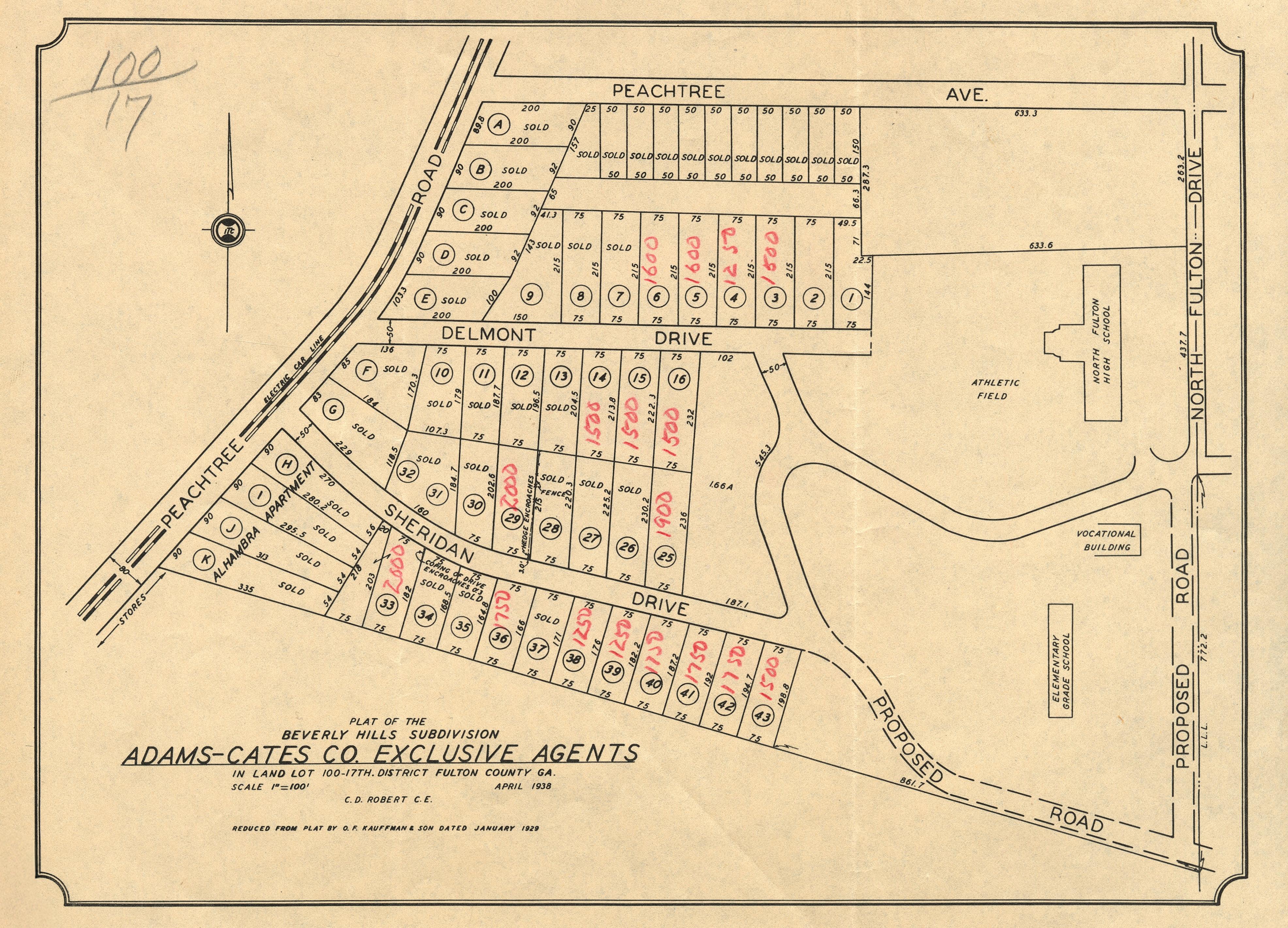
By 1938, Adam-Cates Co. was the exclusive real-estate agent for the Beverly Hills Subdivision (now part of Delmont/Sheridan Garden Hills). Their advertisement boasted of the neighborhood: “. . . with the completion of the new grade school near North Fulton High School, it will be possible for your children to go from first grade through high school without having to cross Peachtree Road traffic—and you won’t have to get up early of a morning to drive them.” Lots were listed for between $1,750 and $2,000. Present-day Alhambra Apartments, built in 1927, were located on Lots H through K fronting Peachtree Road. Courtesy of the Atlanta History Center.
Winecoff Sr. was a wellknown builder and developer, participating as a key investor and builder of Ansley Park (in 1904) as well as constructing the prominent Winecoff Hotel (now Ellis Hotel) in downtown Atlanta in 1913. He and his wife, Gracie, lived in a topfloor apartment there after their Ansley Park mansion burned to the ground. Tragically, a blaze would engulf the hotel the evening

(Above) The Alhambra Apartments at 2855 Peachtree Road were built in 1927 by J. H. Whisenant. It was described as “an exotic threestory tall Moorish Revival-style building featuring rough-cast stucco finish, Spanish tile gable roof, arched balconies with wrought-iron rails and a flamboyant multi-arched entrance porch.” All four sides of the building have distinctive, projecting balconies and porches. H. G. Shaw of Covington, Georgia, bought the building for $250,000 and welcomed renters on January 1, 1928. Since 2005, the historic building has been converted to a sixty-five-unit condominium and multi-level townhouses. Courtesy of the Atlanta History Center.
(Right) The former Beverly Hills Inn apartments at 65 Sheridan Drive were built circa 1929. It is rumored that spirits of three elderly women roam the premises—complete with hazy apparitions and ghostly whispers. The arched “causeway” entrance shown is a distinct architectural feature of the pre-WWII apartment buildings of Sheridan Drive as well as The Alhambra fronting Peachtree Road, all part of the early Beverly Hills Subdivision (circa 1923) that would later become Garden Hills. Courtesy of Mary-Heather Tatum.
of December 7, 1946, killing 119 people. Sadly, both Gracie and William Winecoff lost their lives in the fire.
In the mid-1940s, son Albert Fleming Winecoff (1894–1955), joint owner of real-estate venture Beverly Hills Inc., purchased the Garden Hills Spanish-Mediterranean home at 132 Rumson Road. The former Beverly Hills Subdivision sat just behind it. Albert later operated A. F. Winecoff & Company produce firm with his son, A. F. Winecoff Jr.

